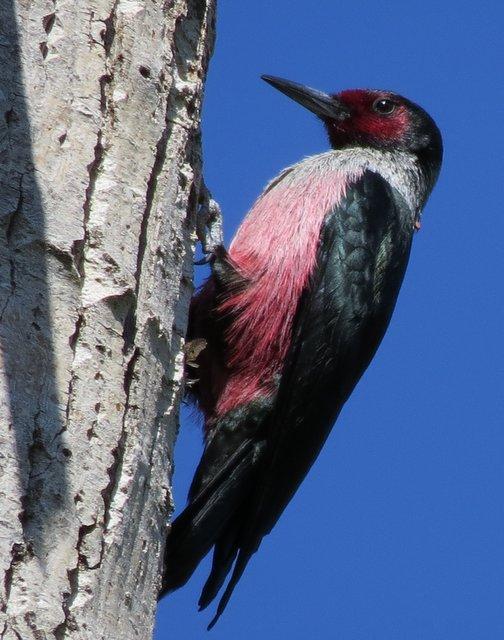Low-
Moderate
The population of Lewis's woodpecker in Washington is low and trend points to it declining. This species may be impacted by habitat loss and effects of fire suppression practices. Intensive forest management and salvage harvest of trees in recently-burned forest may preclude or limit breeding in such areas. Historically, breeding records included many areas in western Washington, but there have been no breeding records in that region for decades.
Description and Range
Physical description
This is a dark woodpecker about 10 inches long. Adults have a dark-green head and back, a red face and reddish belly, transitioning to a pink chest and merging to a light gray upper breast and collar around the neck.
Ecology and life history
Lewis’s woodpecker is typically restricted to lower elevation forests. It breeds in cavities of dead and dying trees in ponderosa pine forests and oak woodlands with open canopy (less than 30 percent canopy cover), as well as riparian cottonwood with a brushy undergrowth (such as sage brush, bitterbrush) and larger (greater than 20 inches diameter at breast height) snags of late decay stages. In addition, it often nests in recently burned forest, and dead trees in open clearings.
Birds that overwinter in eastern Washington are often associated with oak woodlands and commercial orchards. During winter, food supply is the most important aspect of habitat selection, and is dependent on conifer seed, mast and nut production.
Lewis’s woodpecker prefers snags of advanced decay and softer woods (such as cottonwood, aspen) for nesting. This species rarely drills bark, as it lacks the physical structural integrity to excavate or forage in harder woods.
Its main diet is insects in spring and summer, fruit and berries in late summer/fall, and conifer seeds and acorns in winter.
They are strongly site-faithful, and a life-long pair bond is suspected.
Geographic range
The Lewis's woodpecker is uncommon in summer in eastern Washington and generally rare in winter. It is rare in western Washington. Many individuals from Washington appear to move southward for the winter. Breeding Bird Survey data indicate only a slight decline between 1999 and 2009. Breeding season territories reported to vary between 2.5 to 15 acres in the Blue Mountains. Foraging ranges broadly overlap and large numbers may forage together where there is a local abundance of food. The size of Washington’s breeding population is unknown.
For a map of range-wide distribution and conservation status of this species, check out NatureServe Explorer.
Climate vulnerability
Sensitivity to climate change
Low-
Moderate
Warmer temperatures and precipitation changes influence sensitivity of Lewis' woodpecker by affecting prey availability and habitat extent. Warmer temperatures are linked with higher surface-bark insect abundance and enhanced forage opportunities, which are thought to control the timing of woodpecker breeding more than photoperiod. Altered wildfire regimes may affect habitat extent, although this species is often classified as a specialist in burned pine forest habitat.
Exposure to climate change
Moderate
- Increased temperatures
- Altered fire regimes
Conservation
Conservation Threats and Actions Needed
- Fish and wildlife habitat loss or degradation
- Threat: Conversion to agriculture and development. Habitat fragmentation may isolate remaining populations. Urban-wildlife interface and clearing of forest habitats (cottonwood, low elevation ponderosa pine) in/near human habitation.
- Action Needed: Use land acquisitions, conservation easements and landowner agreements to protect habitat. Work with country planners to establish buffers for habitat. Work with landowners to reduce the density of younger trees in ponderosa pine forests; in some areas, this will enhance oak development.
- Threat: Unknown population size and extent.
- Action Needed: Understand and map forest burned areas, low elevation open pine stands and cottonwoods to determine source habitats and landscapes.
- Agriculture side effects
- Threat: Loss of mature and old trees with cavities; harvested and snag habitat felled for human safety reasons.
- Action Needed: Restore open ponderosa pine conditions that mimic natural fire regimes; maintain and recruit large diameter snags; retain large live cottonwoods.
See the Climate vulnerability section for information about the threats posed by climate change to this species.
Resources
References
Lewis, J. C., M. Whalen, and E. A. Rodrick. 2002. Lewis’ Woodpecker. Priority Habitats and Species, Vol. IV: Birds.
Washington Dept. of Fish and Wildlife, Olympia, Washington.
Tobalske, B. W. 1997. Lewis’ Woodpecker. Birds of North America 284: 1-28.
Vierling, K. T., V. A. Saab, and B. W. Tobalske (2020). Lewis's Woodpecker (Melanerpes lewis), version 1.0. In Birds of the World (A. F. Poole, Editor). Cornell Lab of Ornithology, Ithaca, NY, USA. https://doi.org/10.2173/bow.lewwoo.01
Zhu, X., D. S. Srivastava, J. N. M. Smith, and K. Martin. 2012. Habitat selection and reproductive success of Lewis’ woodpecker (Melanerpes lewis) at its northern limit. PloS ONE 7(9): e44346. DOI: 10.1371/journal.pone.0044346.


